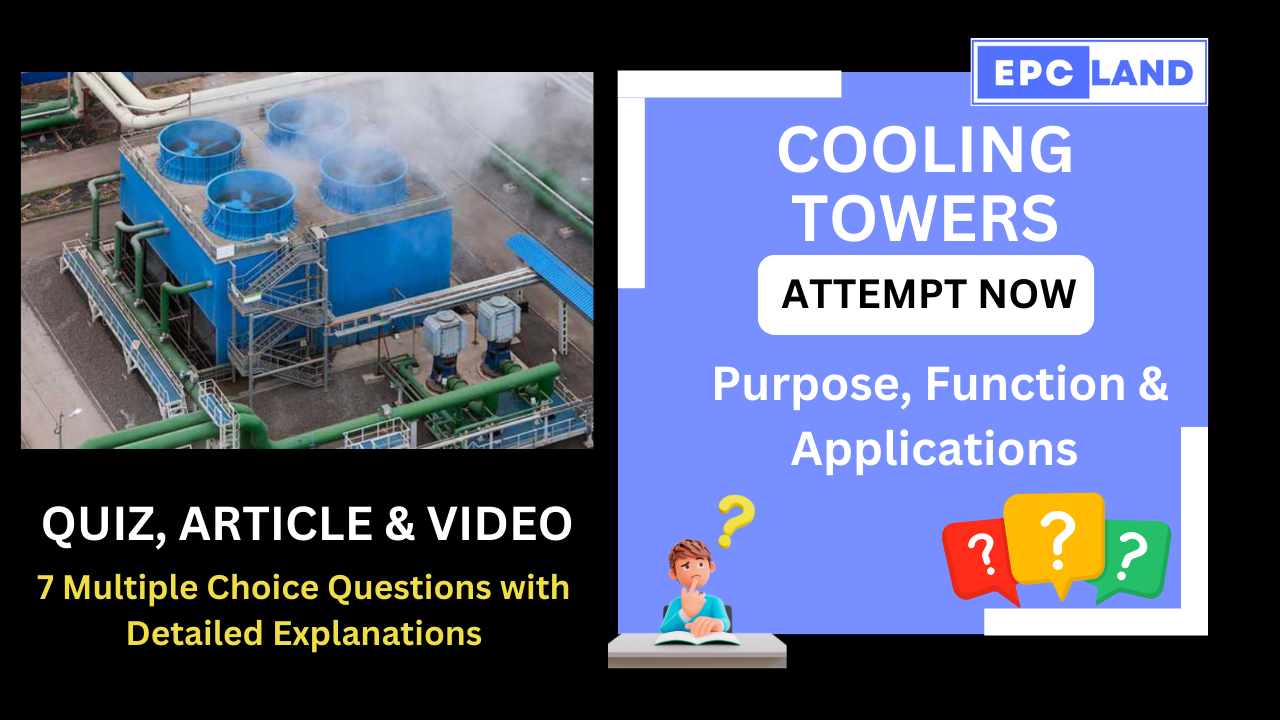
1. Understanding the Cooling Towers: Purpose of Water Cooling Towers
Why are water cooling towers used?
Explanation: Water cooling towers are used to cool down water that has been heated up by air conditioning equipment or industrial processes.
2. Function of Water Cooling Towers: Understanding the Cooling Towers
What happens when warm water from the system flows through the cooling tower?
Explanation: When warm water flows through the cooling tower, it is sprayed into small droplets, increasing surface area and facilitating heat transfer.
3. Airflow in Water Cooling Towers: Understanding the Cooling Towers
How does airflow in water cooling towers contribute to the cooling process?
Explanation: Fans draw in air from the bottom, move it up through the tower, opposite the direction of water flow, and heat is transferred from the water to the air through evaporation.
4. Applications of Water Cooling Towers
Where are commercial cooling towers commonly used?
Explanation: Commercial cooling towers are commonly used in large buildings like airports, hotels, and hospitals for comfort cooling.
5. Benefits of Water Cooling Towers
What is a key benefit of water cooling towers for industrial processes?
Explanation: A key benefit is that water cooling towers provide an efficient and cost-effective way to remove heat from industrial processes.
6. Additional Points
What are some additional points mentioned in the explanation?
Explanation: The explanation mentions different types of water cooling towers, such as open and closed systems, highlighting their importance for increased manufacturing demands.
7. Overall Function of Water Cooling Towers
What is the overall function of water cooling towers in industrial and commercial settings?
Explanation: The overall function of water cooling towers is to cool down water for the efficient operation of equipment and processes in industrial and commercial settings.
Don’t miss the following related topics on Cooling Towers
Short Article on Understanding the Cooling Towers
Definition
A cooling tower is a device that removes heat from water by bringing it into contact with air. This process can be used to cool water in a variety of applications, including:
- Industrial processes: Cooling towers are used in power plants, refineries, and other industrial facilities to remove heat generated by machinery and equipment.
- HVAC systems: Cooling towers are used to cool water in air conditioning systems.
- Data centers: Cooling towers are used to cool the servers and other equipment in data centers.
Purpose:
- Water cooling towers are used to cool down water that has been heated up by air conditioning equipment or industrial processes.
- They act as a large heat exchanger, expelling heat into the atmosphere and returning colder water to the system.
- This allows equipment and processes to function efficiently and comfortably.
Function:
- Warm water from the system flows through the cooling tower.
- Nozzles spray the water into small droplets, increasing surface area and facilitating heat transfer.
- Fans draw in air from the bottom and move it up through the tower, opposite the direction of the water flow.
- Heat is transferred from the water to the air through evaporation.
- Cooled water returns to the system, and the cycle repeats.
Applications:
- Industrial cooling towers are crucial for various industries, including power plants, refineries, and manufacturing facilities.
- They help remove process heat generated during production, ensuring efficient operation.
- Commercial cooling towers provide comfort cooling for large buildings like airports, hotels, and hospitals.
Benefits:
- Efficient and cost-effective way to remove heat from industrial processes and air conditioning systems.
- Enables equipment and processes to operate at optimal levels.
- Provides comfortable cooling for large buildings.
Additional points:
- The explanation mentions different types of water cooling towers, such as open and closed systems.
- It also highlights the importance of industrial cooling towers in the context of increased manufacturing demands and the need for efficient heat removal.
Table of Contents
Don’t miss the Course on Effective Isometrics Management: Check Now
Enrollment Link
Recommended courses (Published on EPCLand)
- Complete Course on Piping Engineering
- Basics of Piping Engineering
- Piping Layout Engineering
- Piping Material Engineering
- Piping Stress Analysis
- Material Requisitions
- Piping Material Specifications
- Valve Material Specifications
- Plant Design & Layouts-OISD 118
- Isometric Management
Library of Technical Articles
Don’t miss out the collection of 15+ articles on following topics:
- Basics of Oil and Gas Industry
- Valves
- Testing
- Tank
- Piping Bulk Items
- Pipe
- Metallurgy
- Piping Materials
- Layout
- Instrumentation
- Heat Exchanger
- Type of Contracts
- Codes and Standards
- ASTM Standards
- Articles on Piping Specialty Items
Video details of Complete Course on Piping Engineering
Why Enroll in the EPCLand
Proven Track Record– PTR
Activities & Achievements before launching EPCLand
- Published more than 50+ short courses
- 3000+ Enrolments
- More than 3,500,00 Minutes of watch hours in the last 2 years
- 4000+ Students in 100+ Countries
- Rating of 4+ out of 5
- 1000+ YouTube Videos
- 8K+ Subscribers
What Students will Learn
- Codes & Standards of the Energy Sector
- Piping Material Engineering
- Piping Layout Engineering
- Stress Analysis
Interesting facts
- All the published courses have been developed by Industry Experts with more than 2 decades of experience
- Content is based on Practical experience and real-time problems.
- Content is designed and organized in such a manner that it can be easily grabbed.
- Complete website, Blogs and Quiz sections are Planned, Designed and published by myself (About me: Atul Singla)
- Complete flexibility of Time & Location, Students can access the content from anywhere & anytime
- Moreover, once enrolled, the content can be access as many times as you want, which helps in understand the fundamentals in a better way.
Conclusion
In conclusion, our courses are meticulously crafted by industry experts with over two decades of hands-on experience. The content is rooted in practical knowledge, addressing real-time problems. The material is thoughtfully designed and organized for easy comprehension. Every aspect, from the website to blogs and quizzes, has been planned, designed, and executed by Atul Singla, ensuring a comprehensive and seamless learning experience. With the flexibility of accessing the content at any time and from any location, students have the freedom to learn on their terms. Furthermore, enrollment grants unlimited access, allowing learners to revisit the material as often as needed, fostering a deep understanding of the fundamentals.



